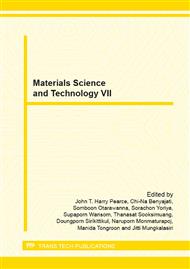p.69
p.77
p.82
p.89
p.95
p.101
p.109
p.115
p.122
The Effect of Titanium Dioxide and Additives on Heat Reflection and Thermal Reduction of Paint
Abstract:
This work aimed to investigate the effects of titanium dioxide (TiO2) content as well as type and content of additives on heat reflection and thermal reduction of external roof paint. Three additives were used including 80-micron glass microspheres (RM1), 40-micron glass microspheres (RM2) and the commercial insulated resin mixed with 80-micron glass microspheres (RM3). The three-layer paint structure (topcoat, middle insulating layer, and bottom rust-protective layer) coated on zinc plate was used. TiO2 (23-32 %wt) was incorporated into topcoat layer while the additives (0.5, 1 and 2 %wt) were added into the middle layer. Thickness of the topcoat and bottom layer was 100 microns and that of the middle layer were 100 and 200 microns. The results revealed that TiO2 improved heat reflectivity of paint film and the optimum reflectance was obtained at 28 %wt TiO2 loading. All of the microsphere additives enhanced thermal reduction through its insulating nature. It was found that higher content of additives gave larger thermal reduction and larger microsphere (RM1) gave a larger thermal reduction than that of the smaller ones (RM2). The incorporation of 1 %wt RM3 in the middle layer (200-micron thick) gave the best results which can lower the internal temperature up to 7 °C compared to the standard roof paint formulation. Note that adding too much additive (2 %wt of RM3) caused phase separation and high surface roughness in the middle layer, and resulted in catastrophically drop in thermal reduction ability.
Info:
Periodical:
Pages:
95-100
Citation:
Online since:
March 2013
Price:
Сopyright:
© 2013 Trans Tech Publications Ltd. All Rights Reserved
Share:
Citation:


